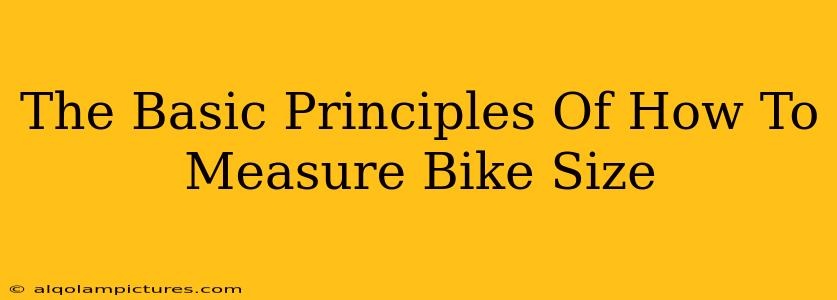Finding the perfect bike fit is crucial for comfort, performance, and injury prevention. Knowing how to measure your bike size accurately is the first step towards a smooth and enjoyable ride. This guide breaks down the basic principles, helping you understand the process and choose the right bike for your needs. We'll cover the key measurements and explain how they translate into finding your ideal bike size.
Understanding Bike Sizing Systems
Before diving into measurements, it's vital to understand that bike sizing isn't standardized across all brands. Manufacturers use different systems, often leading to confusion. You'll commonly encounter systems based on:
-
Wheel Size: This is the most straightforward, particularly for kids' bikes and mountain bikes. Wheel sizes (e.g., 20", 24", 26", 27.5", 29") directly impact the overall bike size. However, it doesn't account for frame geometry.
-
Frame Size: This method focuses on the length of the seat tube (the vertical part of the frame). Frame sizes are typically expressed in inches or centimeters. It's a more traditional method but doesn't fully capture all aspects of fit.
-
Reach and Stack: These measurements (expressed in millimeters) are becoming increasingly popular, especially for road bikes and performance bikes. Reach refers to the horizontal distance from the bottom bracket to the head tube, while Stack refers to the vertical distance. These measurements give a much more precise indication of the bike's geometry and its suitability for different riders.
What to do if the sizing chart is confusing
If you are struggling to decipher a particular manufacturer's sizing chart, don't hesitate to contact the company directly or visit a local bike shop. They are usually very helpful and knowledgeable about bicycle sizing.
Key Measurements for Determining Your Bike Size
Accurate measurements are key. While some online calculators exist, it's best to get measured professionally or follow these guidelines meticulously:
1. Inseam Measurement:
This is perhaps the most crucial measurement. It's the distance from your crotch to the floor, measured while wearing shoes. Use a measuring tape and stand straight against a wall. You'll use your inseam to estimate the appropriate seat tube length (frame size) for many bikes.
2. Arm Length:
Measure from your shoulder bone (acromion process) to your wrist bone. This helps determine handlebar reach and stem length for optimal hand position.
3. Torso Length:
Measure from your hip bone (greater trochanter) to the top of your shoulder. This, combined with your inseam, helps determine the proper frame size and overall fit.
4. Leg Length:
Measure the length of your inner leg. This additional measurement provides more detailed information regarding your fit requirements.
Using Your Measurements to Choose a Bike
Once you have your measurements, you can begin to match them to bike sizes. Many manufacturers provide sizing charts that correlate inseam or reach/stack measurements to recommended frame sizes or wheel sizes. Remember: These charts are guidelines. The best way to find the perfect fit is often through a professional bike fitting.
Finding a professional bike fit
Investing in a professional bike fit is a great way to ensure optimal comfort and performance. They will measure you precisely, helping you to select a bike which fits correctly.
Beyond the Numbers: Test Rides and Adjustments
Even with precise measurements, a test ride is invaluable. Pay attention to your comfort level and posture. Can you comfortably reach the handlebars and pedals? Does your back feel strained? Many bikes allow for adjustments to the seat height, handlebar position, and stem length which can further improve your ride. Don't hesitate to experiment within the adjustments allowed to achieve a perfect fit.
Conclusion: Finding Your Perfect Ride
Choosing the right bike size is a process. By understanding the different sizing systems and taking accurate measurements, you can significantly narrow down your options. Remember that professional bike fitting services can provide the highest level of accuracy. Don't be afraid to ask questions and get advice from experts. The ultimate goal is to find a bike that is comfortable, allows you to ride efficiently, and enables you to enjoy the ride to the fullest.

